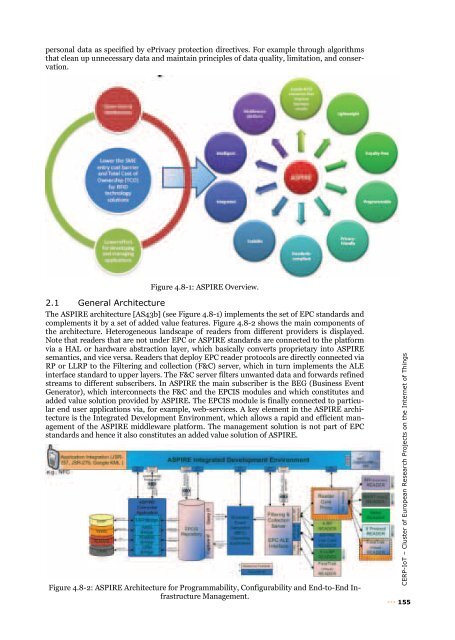Vision and Challenges for Realising the Internet of Things
Vision and Challenges for Realising the Internet of Things
Vision and Challenges for Realising the Internet of Things
Create successful ePaper yourself
Turn your PDF publications into a flip-book with our unique Google optimized e-Paper software.
personal data as specified by ePrivacy protection directives. For example through algorithms<br />
that clean up unnecessary data <strong>and</strong> maintain principles <strong>of</strong> data quality, limitation, <strong>and</strong> conservation.<br />
Figure 4.8-1: ASPIRE Overview.<br />
2.1 General Architecture<br />
The ASPIRE architecture [AS43b] (see Figure 4.8-1) implements <strong>the</strong> set <strong>of</strong> EPC st<strong>and</strong>ards <strong>and</strong><br />
complements it by a set <strong>of</strong> added value features. Figure 4.8-2 shows <strong>the</strong> main components <strong>of</strong><br />
<strong>the</strong> architecture. Heterogeneous l<strong>and</strong>scape <strong>of</strong> readers from different providers is displayed.<br />
Note that readers that are not under EPC or ASPIRE st<strong>and</strong>ards are connected to <strong>the</strong> plat<strong>for</strong>m<br />
via a HAL or hardware abstraction layer, which basically converts proprietary into ASPIRE<br />
semantics, <strong>and</strong> vice versa. Readers that deploy EPC reader protocols are directly connected via<br />
RP or LLRP to <strong>the</strong> Filtering <strong>and</strong> collection (F&C) server, which in turn implements <strong>the</strong> ALE<br />
interface st<strong>and</strong>ard to upper layers. The F&C server filters unwanted data <strong>and</strong> <strong>for</strong>wards refined<br />
streams to different subscribers. In ASPIRE <strong>the</strong> main subscriber is <strong>the</strong> BEG (Business Event<br />
Generator), which interconnects <strong>the</strong> F&C <strong>and</strong> <strong>the</strong> EPCIS modules <strong>and</strong> which constitutes <strong>and</strong><br />
added value solution provided by ASPIRE. The EPCIS module is finally connected to particular<br />
end user applications via, <strong>for</strong> example, web-services. A key element in <strong>the</strong> ASPIRE architecture<br />
is <strong>the</strong> Integrated Development Environment, which allows a rapid <strong>and</strong> efficient management<br />
<strong>of</strong> <strong>the</strong> ASPIRE middleware plat<strong>for</strong>m. The management solution is not part <strong>of</strong> EPC<br />
st<strong>and</strong>ards <strong>and</strong> hence it also constitutes an added value solution <strong>of</strong> ASPIRE.<br />
Figure 4.8-2: ASPIRE Architecture <strong>for</strong> Programmability, Configurability <strong>and</strong> End-to-End Infrastructure<br />
Management.<br />
CERP-IoT – Cluster <strong>of</strong> European Research Projects on <strong>the</strong> <strong>Internet</strong> <strong>of</strong> <strong>Things</strong><br />
155
















